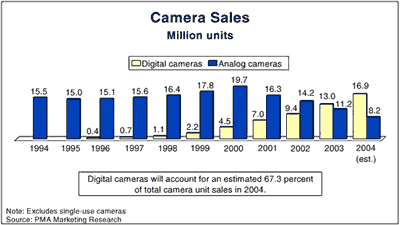Digital Camera Trends - 2004 and Beyond
 Newsline International Press Release
Newsline International Press Release
According to the recently completed 2003-2004 PMA U.S. Industry Trends Report: Retail Markets digital camera sales are estimated to have grown 30 percent in 2004 to 25.1 million units and accounted for 67 percent of all camera sales. Digital camera penetration is expected to be slightly above 40 percent of the U.S. household population compared to almost 30 percent in 2003. These positive trends are expected to continue through 2005 and 2006, and then unit sales are projected to peak in December 2006 when household penetration is anticipated to reach 63 percent. Sales will continue as consumers upgrade or buy additional cameras, but replacement cycles will lengthen as further improvement of features will have less of an impact on consumer satisfaction. For example, upgrading from a 2-megapixel camera to a 4-megapixel camera provides substantially more benefit to consumers than switching from a 6- to 8-megapixel model since the difference in quality is much less noticeable to most consumers.
Adoption of printing services lagged behind that of digital cameras, but as consumers became interested in printing their digital images a variety of home and retail printing options have emerged and the number of digital prints made has rapidly grown. In 2004, digital prints are estimated to have reached 4.9 billion prints and are projected to grow 51 percent in 2005 to 7.4 billion and account for 28 percent of total print volume. Total print volume-which includes home printing-was down in 2004, but in 2005 it is expected to remain flat at 26.3 billion prints. Printing of traditional film and digital prints at retail, however, will fall from 23.2 to 22.4 billion prints. So, while retail digital printing will grow it will not offset retail volume losses of traditional film processing.
Looking to the future, after digital camera sales peak, retailers will need to continue to focus on sales of consumables and accessories. And as digital cameras become the primary camera for most households, continuous innovation of printing and services will be necessary for retailers to continue to generate revenue. In addition to growing the number of prints made, retailers will need to stimulate usage of unprinted images through new sharing and custom product options. If retailers do not continuously improve their offerings, some images will go unused and more consumers may choose to print at home.
